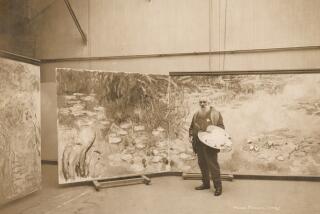Painting thought to be by Delacroix discovered in Santa Barbara
SANTA BARBARA -- Eik Kahng, curator at the Santa Barbara Museum of Art, believes she has identified a previously unknown painting by Eugène Delacroix (1798-1863). Given the stature of the French Romantic innovator, that’s no small thing.
The painting turned up in a local private collection -- the Van Asch van Wyck Trust -- and Kahng has now included it in her newly opened exhibition, “Delacroix and the Matter of Finish,” which looks at the rebukes the controversial artist received from those who thought his painterly canvases looked unfinished. (He was crazy for Rubens, and things don’t get more painterly than that.)
A modest presentation, with just 22 easel paintings by Delacroix and an additional five by students, plus numerous prints and drawings, it is also of note for what the museum says is the first Delacroix exhibition ever organized on the West Coast.
CHEAT SHEET: Fall arts preview
Based on a recent visit, it’s the new and to my eyes rather persuasive attribution that’s most noteworthy. In the catalog Kahng writes, “I feel very confident that the [painting] is entirely by the hand of Delacroix.” The show displays it with a drawing, a related oil sketch and a known copy, perhaps by studio assistant Pierre Andrieu. It will be interesting to see what other scholars of 19th century French art think.
The small painting is a variant of a monumental Delacroix canvas in the collection of the Museum of Fine Arts in Lyon, France. As deathbed scenes go, “The Last Words of Marcus Aurelius” has a lot to recommend it. Critics at the official 1845 Paris Salon didn’t think so – they mostly trashed the picture -- with the notable exception of the always astute Charles Baudelaire. He called the big history painting “splendid, magnificent, sublime.”
As the once-powerful Stoic philosopher-emperor slips away, his greenish skin gone sickly, Marcus beseeches his assembled cronies and friends to get behind his son, Commodus, anointed as his successor. He clings to the arm of the preening and muscular youth, wrapped in a scarlet toga; the young man has a hard and indifferent air, rather like a spoiled brat.
PHOTOS: Arts and culture in pictures by The Times
Which is, of course, pretty much what the dissolute new emperor turned out to be. Some historians even trace the start of the Roman Empire’s decline to Commodus’ rise to power.
Baudelaire didn’t fully elaborate his thoughts on the picture, but he may have been responding to its inescapable undercurrent of dashed hopes. I wonder what he would have thought of the second version. It’s quite different -- and I’d say revealing.
The general composition is the same, with subtle changes that include a refocused play of light and spatial alterations in the figures’ placement. What’s most interesting, though, is how dramatically the artist has transformed Commodus.
In the big picture he’s a robust and surly teenager; in the little one he’s a pretty, effeminate boy.
The Lyon picture implores the dying emperor’s followers to at least give a shot to the callow youth, who might mature. The Santa Barbara variant makes a plea for a girly-man, whose fate in this dispiriting crowd would seem to be sealed. Girlishness is here the character trait that signals the imminent decline of Stoicism and the coming collapse of empire.
ART: Can you guess the high price?
When Delacroix painted the works, politically tumultuous France was in the midst of protracted conflict with Algeria (the scarlet-robed boy, a gold cuff on his arm and hoops in his earlobes, is almost a harem girl). The ruling government, the July Monarchy, was beginning to unravel. Louis Philippe, the last king, would be forced into exile in 1848, and power would soon be up for grabs.
The big Lyon painting, made for the official Salon exhibition, was Delacroix’s public statement on the perils of imperial power. The small Santa Barbara easel picture is more personal and private. In the 1840s its sexist metaphor of social weakness would have seemed benign, but to contemporary eyes it’s pretty blatant.
ALSO:
Rembrandt smiles on Getty Museum visitors and staff
Deborah Gribbon heading back to Cleveland Art Museum
Cirque du Soleil says it will appeal OSHA citations in ‘Ka’ death
More to Read
The biggest entertainment stories
Get our big stories about Hollywood, film, television, music, arts, culture and more right in your inbox as soon as they publish.
You may occasionally receive promotional content from the Los Angeles Times.











